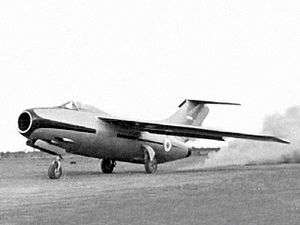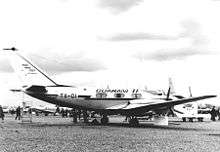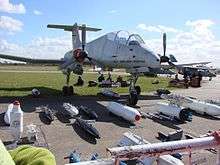Fábrica Argentina de Aviones
The Fábrica Argentina de Aviones SA (FAdeA), officially Fábrica Argentina de Aviones "Brigadier San Martín" S.A., is Argentina's main aircraft manufacturer. Founded on 10 October 1927 and located in Córdoba, for most of its existence it was known as Fábrica Militar de Aviones (FMA), until its privatization in the 1990s to Lockheed Martin. In 2009 the concession ended and is wholly owned by the Argentine government.
 | |
 | |
| Sociedad Anónima | |
| Industry | Aerospace, Defense |
| Founded | 1927 |
| Founder | Francisco de Arteaga |
| Headquarters | Córdoba, Argentina |
Key people | Matías Julián Savoca (chairman)[1] |
| Products | Aircraft, aircraft components, aircraft maintenance and services |
Number of employees | 1,600 (as of June 2014) |
| Website | www.fadeasa.com.ar |
History

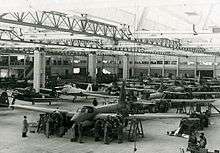
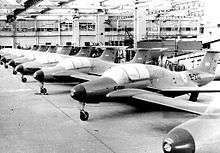
Formed on 10 October 1927 and on 18 July 1928 ends the construction and testing begins on the track the first domestically produced aircraft: the license built Avro 504 Gosport training aircraft equipped with a 100 hp (75 kW) Gnome engine. It had a speed of 140 km/h with a flying endurance of 2 hours. A series of indigenous and foreign designs followed, mostly for military use.
The factory is known for producing the first jet fighter aircraft in Latin America: the Pulqui I (1947) and the Pulqui II (1950) under the direction of engineers Emile Dewoitine (French) and Kurt Tank (German) respectively.
In the 1960s produced the Guarani light transport and the Pucara COIN aircraft, followed by the Pampa jet trainer in the 1980s; the last two still in service with the Argentine Air Force as of early 2016.
Privatization (1995)
In 1995, FMA was privatized by the government of Carlos Menem and from that year until March 2009 it operated as a concession to LAASA (Lockheed Aircraft Argentina SA, a subsidiary of Lockheed Martin Corporation). Under the terms of the privatization agreement LAASA would operate it for 25 years, which could be renewed for two 10 year periods.
During this period the activity was mostly focused in maintenance and upgrades of existing aircraft in service with the Argentine Air Force.
Nationalization (2010)
During the government of Cristina Fernández de Kirchner the factory was nationalized in August 2009 after paying ARS $67 million. The text of the expropriation law provides that "the State cannot divest itself of majority shareholdings or the power to make decisions at the factory." [2][3]
It was renamed after Argentine Air Force Brigadier es:Juan Ignacio San Martín a military engineer who laid the foundations of the aeronautics industry at Córdoba when he directed the Instituto Aerotécnico, the forerunner of the FMA, in the 1940s.
The United States Department of State announced that effective 18 December 2009, Lockheed Martin Aircraft Argentina would be renamed to Fábrica Argentina de Aviones "Brigadier San Martin" S.A. and divested to the Government of Argentina.[4]
Aircraft design and production
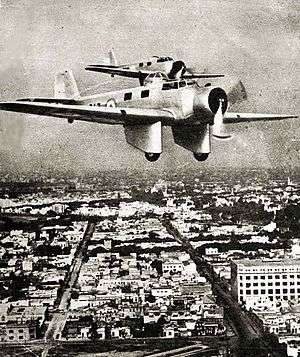

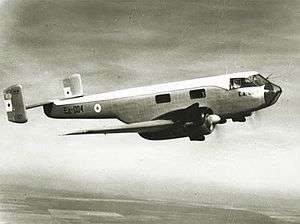
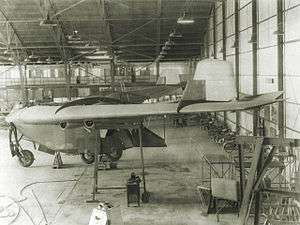
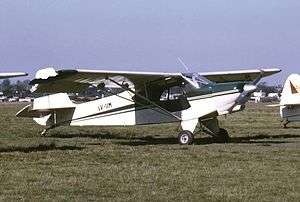
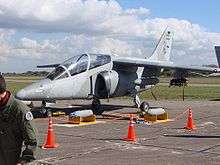
The FMA has produced innovative aircraft prototypes, but the state of the Argentine economy has usually prevented most of them from entering large-scale production. Nevertheless the FMA has managed to put several aircraft types of more conventional designs into full productions. It also engaged in production of licensed aircraft from other countries.
The prefixes used for the aircraft locally developed (and produced) are:
- Ae, for "Dirección General de Aerotécnica", on the first period (1927–1936);
- F.M.A., for "Fábrica Militar de Aviones", on the second period (1938–1943);
- I.Ae., for "Instituto Aerotécnico", on the third period (1943–1952);
- IA, meaning not specified, on the fourth (current) period (1952 to present).
List of aircraft manufactured, projected, or upgraded
| Year | Model | Built | Obs |
|---|---|---|---|
| Started as Instituto Aerotécnico | |||
| 1928 | Avro 504K "Gosport" | 31 | Biplane basic trainer, license-built. First aircraft produced by FMA. |
| 1930 | Dewoitine D.21 | 35 | Monoplane fighter, license-built. |
| 1931 | FMA AeC.1 | 1 | Civil tourism aircraft prototype (initial version); basic trainer (later version). First local design. |
| 1932 | FMA AeC.2 | 2 | Civil tourism aircraft |
| 1932 | FMA AeME.1 | 7 | Basic military trainer |
| 1933 | FMA AeT.1 | 3 | Transport/commercial aircraft |
| 1934 | FMA AeMO.1 | 41 | Observation monoplane |
| 1934 | FMA AeMOe.1 | 6 | Derivative of the AeMO.1, observation and training |
| 1934 | FMA AeMOe.2 | 61 | Variant of the AeMOe.1, observation and training |
| 1934 | FMA AeC.3 | 16 | Civil aircraft. |
| 1935 | FMA AeMB.1 | 1 | First bomber aircraft built by FMA |
| 1935 | FMA AeMB.2 | 14 | First bomber aircraft built by FMA |
| 1935 | FMA AeMS.1 | 1 | Ambulance aircraft |
| 1936 | FMA AeC.3G | 1 | Tourism aircraft. |
| 1936 | FMA AeC.4 | 1 | Improved prototype version of the C.3G |
| Name changed to Fabrica Militar de Aviones | |||
| 1940 | Curtiss Hawk 75O | 20 | License built version of the US monoplane fighter Curtiss Hawk 75[5] |
| 1940 | Focke-Wulf Fw 44J Stieglitz | 190 | License built version of the German biplane trainer |
| 1940 | FMA I.Ae.20 El Boyero | 130 | Tourism aircraft, series built by "Industrias Petrolini" |
| 1943 | FMA I.Ae.21 | 1 | Advanced trainer aircraft prototype, based on the North American NA-16-1P fuselage. |
| 1943 | FMA I.Ae.22 DL | 206 | Advanced trainer aircraft |
| 1945 | FMA I.Ae.23 | 1 | Basic trainer prototype, based on the Focke-Wulf Fw44J |
| 1945 | FMA I.Ae.25 Mañque | 1 | Assault/Transport glider. |
| 1946 | FMA I.Ae.24 Calquín | 100 | Attack/Light bomber |
| 1947 | FMA I.Ae.27 Pulqui | 1 | Jet fighter prototype, first of its kind built in Latin America. |
| 1947 | FMA I.Ae.31 Colibrí | 3 | Two-seat Trainer aircraft |
| 1948 | FMA I.Ae.30 Ñancú | 1 | Fighter/Attack prototype |
| 1949 | FMA I.Ae.32 Chingolo | 1 | Tourism/Trainer aircraft |
| 1949 | FMA I.Ae.34 Clen Antú | 3+1+3 | Glider, flying wing. Designed by Reimar Horten, also known as the Horten XVa and XVb |
| 1950 | FMA I.Ae.33 Pulqui II | 5 | First swept-wing jet fighter designed in Latin America |
| 1951 | FMA I.Ae.36 Cóndor | 0 | Civil passenger transport, designed by Kurt Tank. Project cancelled, no prototypes built. |
| 1953 | DINFIA IA35 Huanquero | 2+3+20+9(+1+1) | Transport aircraft; variants "Constancia" and "Pandora" executive aircraft. |
| 1953 | FMA I.Ae.41 Urubú | 4 | Flying-wing glider, designed by Reimar Horten, also known as the Horten XVc. |
| 1953 | FMA I.Ae.43 Pulqui III | 0 | Project, swept-wing supersonic jet fighter |
| 1954 | FMA I.Ae.37 | 1 | Supersonic delta-wing interceptor, designed by Reimar Horten. Glider, unpowered prototype only. |
| 1960 | I.Ae. 38 Naranjero | 1 | Flying-wing transport/cargo, designed by Reimar Horten. |
| mid-1950s | FMA I.Ae.39 | 0 | Transport, based on the I.Ae.35. Project only. |
| 1956 | FMA I.Ae.40 | 0 | Night fighter project. |
| 1953 | FMA IAe.44 DL.II | 0 | Advanced trainer, project |
| 1959 | DINFIA IA 45 Querandí | 2 | Executive transport, prototypes only (NOTE: some sources mention "1957" and "1" built) |
| 1957 | FMA I.Ae. 46 Ranquel | 101+116 | 2-seat utility aircraft. Second series, enhanced variant "Super Ranquel". |
| 1960 | FMA I.Ae. 48 | Cancelled | Fighter aircraft |
| 1960 | DINFIA IA 35 Guaraní I | 1 | Approximate date, transport derived from the I.Ae. 35 "Huanquero" |
| 1963 | DINFIA IA 50 Guaraní II | 1+2+18+14 | Transport aircraft, derived from the IA 35 Guaraní I |
| Beechcraft T-34 Mentor | 75 | Trainer, licence built | |
| 1965 | IA 53 Mamboretá | 2 | Agricultural aircraft |
| 1960 | Morane-Saulnier MS.760 Paris | 48 | Trainer, licence built |
| 1967 | FMA IA 58 Pucará | 120 | Counter-insurgency/light attack aircraft |
| 1972 | FMA IA-59 | 1 | UAV prototype |
| 1975 | FMA IA 60 | 0 | Advanced trainer/light attack (project)[6] |
| 1978 | FMA IA 62 | 0 | Military trainer (project) |
| 1980 | FMA IA 66 Pucará II | 1 | Single prototype; converted IA-58A powered by two 1,000-ehp (746-kW) Garrett TPE331-11-601W turboprop engines. |
| 1984 | FMA IA 63 Pampa | 20+12 | Advanced trainer. AT-63 currently under production. |
| 1985 | FMA IA 58C Pucará "Charlie" | 1 | Single seat with 30 mm DEFA cannon, air-to-surface missiles, better IR protection. Program cancelled after the prototype was homologated. |
| (mid-1980s) | IA 67 Córdoba | 0 | Light transport (project)[7] |
| (mid-1980s) | IA 68 ATL | 0 | Light transport (project); cancelled |
| (mid-1980s) | FMA SAIA 90 | 0 | Supersonic air superiority jet fighter project; cancelled |
| 1990 | (IA 70) Embraer/FMA CBA 123 Vector |
2 | Turboprop 19-passenger regional airliner, only prototypes built before being cancelled [8] |
| Name changed to Lockheed Martin Aircraft Argentina SA | |||
| 1999 | Lockheed Martin A-4AR Fightinghawk | 18 | Another 18 by Lockheed Martin in Pasadena, California, US. |
| 2003 | Beechcraft T-34 Mentor | Refurbishment of Argentine and Bolivia Air Forces | |
| 2006 | Lockheed C-130 Hercules | Refurbishment of Argentine Air Force and Colombian Air Force aircraft. | |
| Name changed to FAdeA S.A. | |||
| 2009 | FMA IA 63 Pampa II-40 | Changing power plant | |
| 2010 | FMA IA 58 Pucará | 1 | Changing power plant and avionics (cancelled) |
| 2010 | FAdeA IA 73 | Basic trainer to replace the T-34 (cancelled) | |
| 2014 | FAdeA IA 100 | 1 | Elemental trainer and a project to demonstrate the capabilities of the Argentine industry |
| 2018 | IA 63 Pampa III Block I | 3+1+2 | Third evolution of the Pampa aircraft, with 3 more in order for 2019 for the Argentine Air Force. |
Other products and services
- Upgrade and Maintenance
- Boeing 737
- Airbus 320
- Lockheed P-3 Orion
- Lockheed C-130 Hercules
- Fokker F28 Fellowship
- Fokker F27 Friendship
- Embraer EMB 312 Tucano
- FMA IA 58 Pucará
- FMA IA 63 Pampa
- Bell 206
- Manufacture
Gallery
Local designs
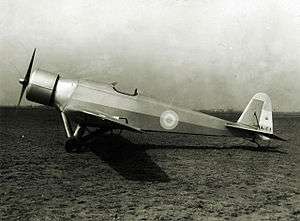 Prototype AeC.1 (1931)
Prototype AeC.1 (1931).jpg) AeC.2 (1932)
AeC.2 (1932)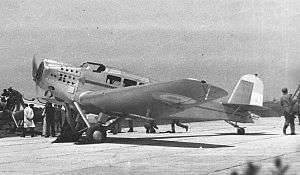 AeT.1 (1933)
AeT.1 (1933)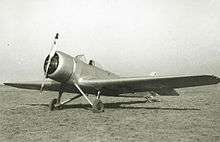 AeMOe.1
AeMOe.1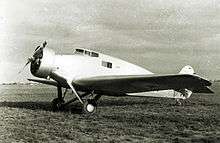 AeMS.1 prototype
AeMS.1 prototype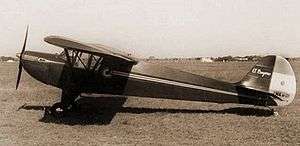 FMA 20 El Boyero (1940)
FMA 20 El Boyero (1940) Prototype FMA 21 trainer (1943)
Prototype FMA 21 trainer (1943)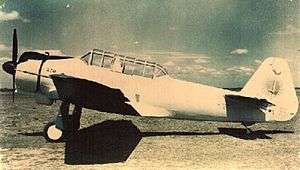 I.Ae. 22 DL advanced trainer (1944)
I.Ae. 22 DL advanced trainer (1944) I.Ae. 23 trainer prototype, based on the FW-44J Stieglitz (1944)
I.Ae. 23 trainer prototype, based on the FW-44J Stieglitz (1944)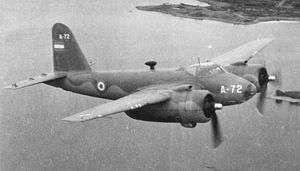 I.Ae. 24 Calquin attack aircraft, c.1950
I.Ae. 24 Calquin attack aircraft, c.1950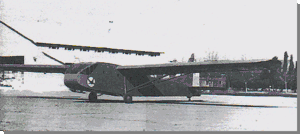 Prototype I.Ae. 25 Mañque glider (1945)
Prototype I.Ae. 25 Mañque glider (1945)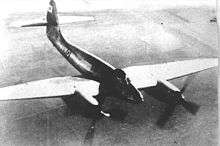 I.Ae. 30 Ñancú (1948)
I.Ae. 30 Ñancú (1948) IAe.31 Colibrí (1947)
IAe.31 Colibrí (1947)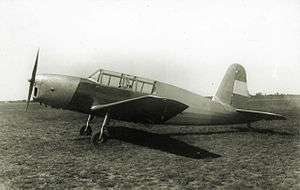 I.Ae.32 Chingolo (1949)
I.Ae.32 Chingolo (1949)- I.Ae.33 Pulqui II prototype 5 (1959), preserved, Tecnópolis show, 2012
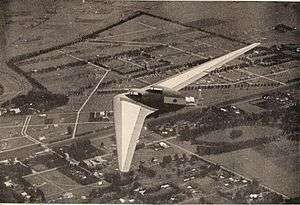 I.Ae. 34 Clen Antú, tailless glider designed by Reimar Horten, late 1940s
I.Ae. 34 Clen Antú, tailless glider designed by Reimar Horten, late 1940s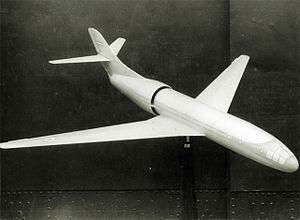 Model I.A. 36 Cóndor, airliner designed by Kurt Tank, early 1950s
Model I.A. 36 Cóndor, airliner designed by Kurt Tank, early 1950s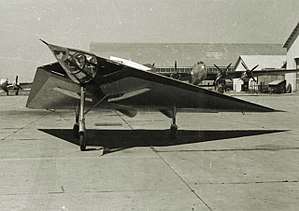 FMA I.Ae. 37 fighter prototype (1953)
FMA I.Ae. 37 fighter prototype (1953)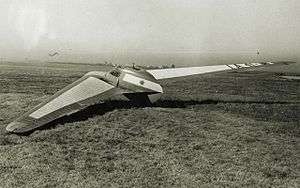 IAe.41 Urubú flying wing glider (1953)
IAe.41 Urubú flying wing glider (1953)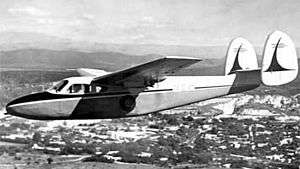 IA 45 Querandi light transport prototype (1957)
IA 45 Querandi light transport prototype (1957)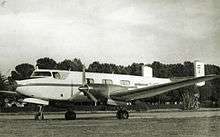 IA 50 Guaraní I (1962)
IA 50 Guaraní I (1962)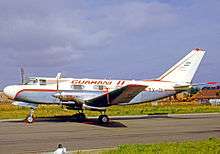 Prototype Guarani II, 1965 Paris Air Salon
Prototype Guarani II, 1965 Paris Air Salon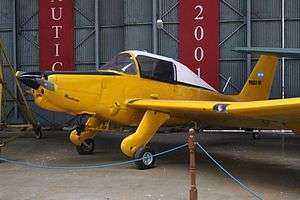 IA 53 Mamboretá agricultural aircraft prototype (mid-1960s)
IA 53 Mamboretá agricultural aircraft prototype (mid-1960s)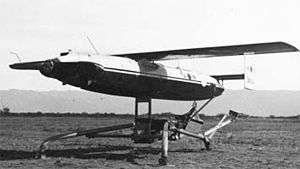 IA-59, prototype Unmanned aerial vehicle, early 1970s
IA-59, prototype Unmanned aerial vehicle, early 1970s FMA IA 63 Pampa, Paris Air Show, 1991
FMA IA 63 Pampa, Paris Air Show, 1991_(PT-ZVE).jpg) CBA 123 / IA 70 prototype, Farnborough 1990
CBA 123 / IA 70 prototype, Farnborough 1990 FAdeA I.A. 73 Unasur I mock-up
FAdeA I.A. 73 Unasur I mock-up.jpg) FAdeA I.A. 100, August 2016
FAdeA I.A. 100, August 2016
Manufactured under license
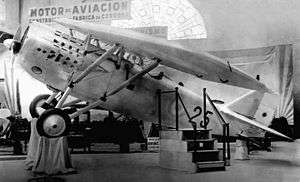 Dewotine D.21
Dewotine D.21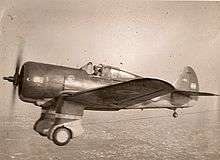 Curtiss Hawk 75O
Curtiss Hawk 75O FW-44J Stieglitz
FW-44J Stieglitz_MS-760_Paris_Lofting-2.jpg) Morane-Saulnier MS-760 Paris, Mendoza, 2005
Morane-Saulnier MS-760 Paris, Mendoza, 2005
Engines
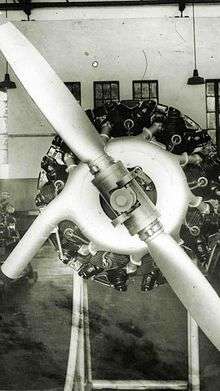 I.Ae. R-16 El Gaucho
I.Ae. R-16 El Gaucho I.Ae. R-19 El Indio
I.Ae. R-19 El Indio
References
Notes
- "FAdeA AUTORIDADES". Archived from the original on 20 December 2014. Retrieved 11 July 2014.
- Back at the hands of the state
- (in Spanish)Ministerio de Defensa - República Argentina Archived 2012-10-07 at the Wayback Machine
- Lockheed Martin Aircraft Argentina SA to Fábrica Argentina de Aviones “Brigadier San Martin” S.A.
- Padin 1999, pp. 9, 15
- (in Spanish)"FMA IA-60 - Anteproyecto de Avión de Entrenamiento y Ataque" - website "Zona Militar" (accessed 2015-06-08)
- "Aeroespacio" magazine Nr.566 (Jul-Ago 2005), Ficha Técnica Nr.53
- CBA123/IA 70 Archived 2010-09-12 at the Wayback Machine
Bibliography
- Bellomo, Sergio; Cordon Aguirre, Arturo; Marino, Atilio; Núñez Padin, Jorge (1999). Núñez Padin, Jorge Felix (ed.). Curtiss Hawk. Serie Fuerza Aérea Argentina (in Spanish). 5. Bahía Blanca, Argentina: Fuerzas Aeronavales.
- Arreguez, Angel Cesar (2008). Mansur, Sergio Luis (ed.). Fabrica Militar de Aviones: Cronicas y Testimonios (in Spanish) (Second ed.). Cordoba, Argentina: Ministerio de Ciencia y Tecnologia de la Provincia de Cordoba. ISBN 978-987-24620-0-0.
Further reading
- (in Spanish) FÁBRICA MILITAR DE AVIONES: CRÓNICAS Y TESTIMONIOS, retrieved 2010-01-18 (PDF file available for download). Published in 2007 by Ministerio de Ciencia y Tecnología de la Provincia de Córdoba, Argentina (Córdoba's Province Science and Technology Ministry)
- (in Spanish) La Argentina fabricante de Aviones (retrieved 2016-04-23)
External links
| Wikimedia Commons has media related to Fábrica Argentina de Aviones. |
